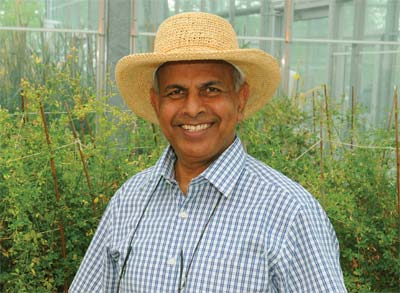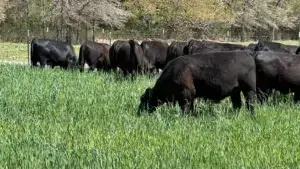Forage Finesse
When Dr. Surya Acharya talks about forage crops, producers listen—intently. The many cultivars he’s developed have profoundly changed the forage crop landscape across Western Canada. Now the recipient of the Canadian Seed Trade Association and Germination’s highest honour, this Canadian research scientist and plant breeder has built a stellar career by breaking with tradition.
Surya Acharya’s contributions to Canadian agriculture through his prolific plant breeding and crop development efforts, his dedication to the improvement of animal nutrition and environmental protection, in addition to his significant research offerings in the field of human nutrition, have made this Agriculture and Agri-Food Canada senior research scientist and plant breeder the object of high praise in many circles, and the recipient of the 2012 Canadian Plant Breeding and Genetics Award.
“From the perspective of a very interested participant in the Canadian seed industry, the volume and diversity of Dr. Acharya’s accomplishments—the release of 12 forage varieties and nine native grass cultivars, as well as a perennial cereal rye—are formidable statements in and of themselves relative to the world-class application of his achievements,” says Ken Miller, owner of Miller Seeds.
Acharya’s advancements in forage crops are providing tremendous economic benefits for Canadians, says Miller. “By calculating a modest production value improvement of $10 to $15 per acre on the 15 million acres of perennial forages in Western Canada, Dr. Acharya’s potential contribution becomes obvious. Many of his plant varieties will grow where nothing of value was grown previously and where inputs were often wasted, making his contribution enormous. The fact that the biggest players in the industry are promoting his varieties, and knowing that others will follow his work and use it as a basis for future developments, makes Dr. Acharya’s contribution astronomical,” says Miller.
Vernon Turchyn, product line manager of forage and special crops for Viterra, says that in addition to Acharya’s creative approach to the development of forage crops, he has also improved agronomic practices for the production management of these cultivars.
“Dr. Acharya’s contributions in the field of forage plant development have been diverse and significant,” says Turchyn. “It is important to note that in addition to his innovative strategies to develop and foster the use of new plant species, such as ACE-1 perennial cereal rye, numerous native plant species and his current work using sainfoin as a bloat safener in alfalfa pastures, he has spent significant resources developing cultural practices to improve the success of their use.”
Unconventional Thinker
Acharya credits his successes with his ability to examine and solve problems in unconventional ways, often offering disparate views from prevailing schools of thought. “We should keep an open mind, and keep our ears and eyes open for any opportunities to understand agriculture, the whole system, and how it operates. Then you can contribute more to the industry than if you think there is only one way to solve a problem,” says Acharya.
For example, almost 30 years ago at the outset of his career, it took some time for Acharya to convince his managers at the Alberta Environmental Centre that the best way to reclaim ecologically-sensitive areas at high elevations in the Canadian Rocky Mountains was to develop and plant native grass cultivars rather than ecovars.
“They didn’t want any cultivars released, but I felt ecovars would be difficult to maintain, so I suggested we do it differently,” he says. “It is not easy when you try to go way outside conventional thinking. But if you persevere, if you have the right idea, then people will eventually believe you.”
Acharya developed and released nine native grass cultivars from germplasm he collected in the mountains. The program was a success, gaining support from peers, industry groups and environmentalists. “I once had a chat with David Suzuki about my native grass breeding work, and he told me what a good job I was doing and to keep up the good work. He said that more people should look at native plants for solving problems in sensitive areas. I felt like I was really contributing something,” says Acharya. The cultivars are still being used for land reclamation projects.
Hired in 1989 by AAFC as a forage breeder at the Lethbridge Research Centre, Acharya continued to find innovative ways to solve problems for forage, cow-calf and beef cattle producers. “I have always tried to see how forage and cattle producers will benefit from any work we do. Although I get research ideas from producers, I believe researchers have to stay about 10 years ahead of producer groups in terms of solutions to their problems. My work on bloat-free forage legumes is a good example of this,” he says.
Acharya’s vast body of work as a forage breeder includes the development and registration of alfalfa cultivars AC Blue J, AC Longview and AC Dalton, high-yielding varieties adapted for Western Canada resistant to bacterial and verticillium wilts; and Bridgeview, the first Canadian saline-tolerant alfalfa cultivar.
Biggest Accomplishment
However, it is his work on bloat-free alfalfa grazing that Acharya says is his most significant contribution to date. With an eye to improving animal welfare and nutrition using bloat-free forage crops, Acharya also considers producers’ economic realities when initiating research projects. “If producers can graze their animals for a longer time—well into the fall and some part of winter—they will reduce their cost of production significantly without negatively impacting the environment or animal health,” he says.
Acharya is responsible for developing two high-yielding, long-lived, bloat-free cicer milkvetch cultivars, AC Veldt and AC Oxley II, which offer improved seedling vigour. To further improve its successful establishment, he has developed an agronomic package for difficult-to-establish crops, such as cicer milkvetch.
His work on fenugreek, an annual bloat-free forage legume crop, resulted in the development of the high-yielding and high-quality cultivar Tristar, which is adapted to Western Canada’s dryland conditions and can be used in short-term rotations.
Although this cultivar does very well as a forage crop, it does not produce high-quality seed every year. At present, in collaboration with his graduate students, Acharya is looking at ways to produce a mutant of the cultivar with determinate growth in order to solve the seed quality issue, also opening doors to increasing its popularity as a nutraceutical crop for humans.
Roger Snow, president of Rocky Mountain Grain Products, says the potential benefits from an early-maturing variety for large-scale production of fenugreek seeds are tremendous. Although they may not know it, many people benefit daily from Acharya’s efforts, says Snow. “Thousands of us know that we are immensely indebted to Dr. Acharya for his work in making better seeds widely available; hundreds of millions of us will benefit from his work indefinitely, without any knowledge of his dedication and focus,” he says.
Acharya is also developing cultivars that can grow with alfalfa—which preserves the advantages alfalfa provides both beef and milk production in the cattle industry—and prevent bloat. To this end, he is developing cultivars of sainfoin that will grow with alfalfa. The condensed tannins in sainfoin prevent bloat; however, the old cultivars do not usually survive in alfalfa pastures. “I took a very different approach to bloat-safe alfalfa grazing,” says Acharya. “I thought if sainfoin can prevent bloat, why not make sainfoin that would survive in these stands.”
Sainfoin does not grow back with alfalfa after the first grazing, creating another issue to resolve. However, Acharya is creating cultivars that not only survive in alfalfa stands, but also grow back at the same rate, preventing bloat for the entire growing season. “Cattle producers are very enthusiastic about this project, and they’re asking me to conduct similar research with cicer milkvetch. They are aware that the quality of cicer milkvetch remains high into the fall, and even under snow during the winter,” says Acharya. “It retains better qualities than alfalfa, so grazing can be extended considerably in Western Canada.” With the sainfoin work close to completion, new cultivars will soon be released, says Acharya.
“I feel inspired when I hear or see that forage producers or people in the cow-calf or beef industry are using my cultivars and are anxious to hear what I have to say,” he adds. “Lately, they are really paying attention to what I am doing and supporting me in my research. Their support gives me a lot of encouragement to keep going.”
His family, friends, team members, technicians and collaborators are also important sources of support and inspiration, says Acharya. “I wouldn’t have been able to do all the things I have done so far without the help I have received from everybody,” he says. “When they realize that we are all working to improve our lives along with the productivity and sustainability of our agricultural systems, they are all willing to help.”
However, it’s Acharya’s commitment to excellence in every aspect of his life that truly sets him apart. “I have told my students and my children the same thing—whatever you do, do the best that you can.”
Kari Belanger












